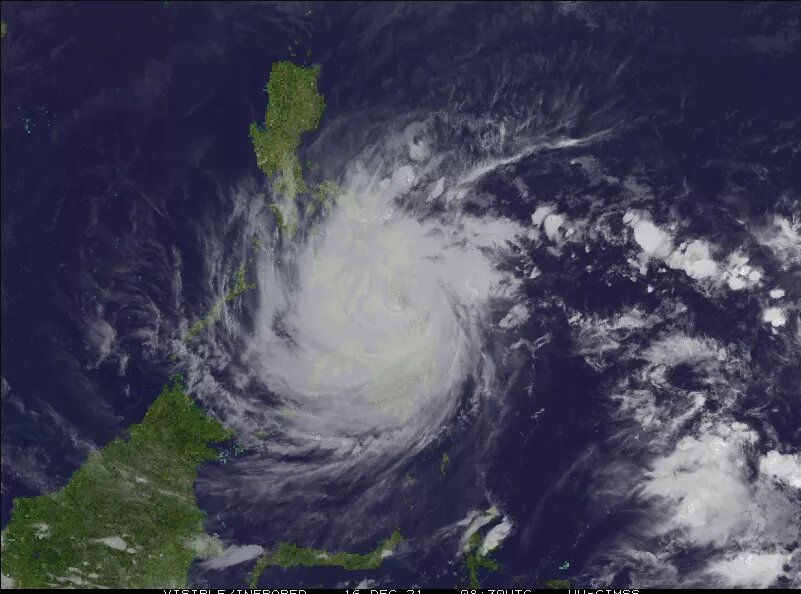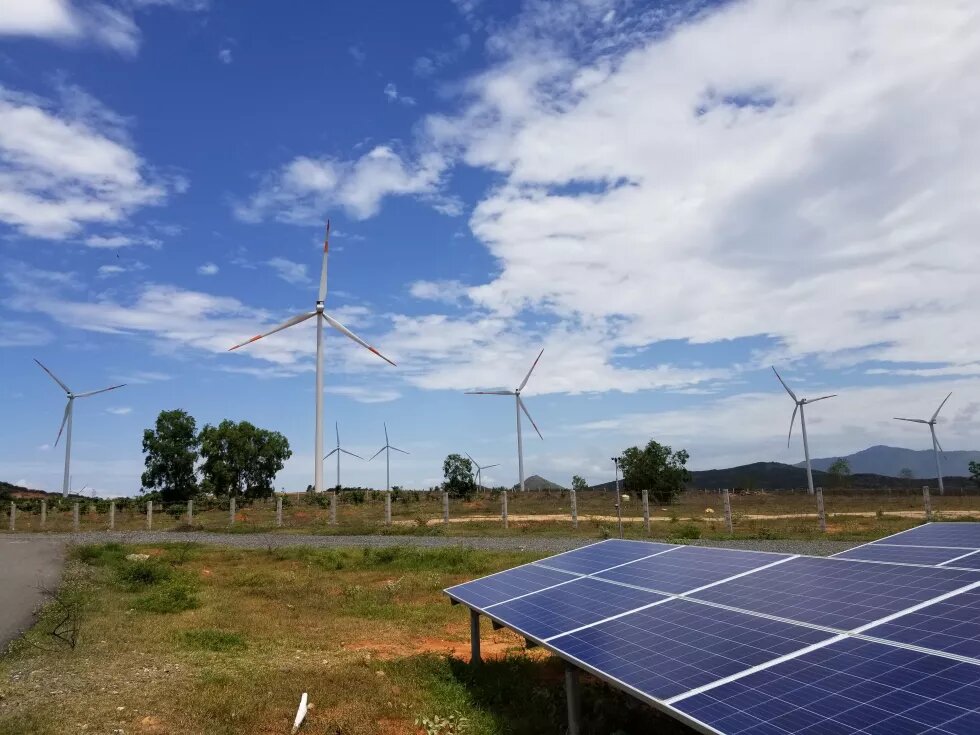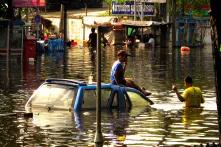
The Philippines has seen increasing storms and typhoons cause havoc with more frequency, however, some groups of people are more vulnerable to the impacts of climate change than others. Though the climate crisis is a human rights issue, a whole-of-government approach is still needed to address ongoing problems left behind by limited relief packages, slow responses from authorities, and excessive waste.

Situated in Southeast Asia between the South China Sea and the Western Pacific Ocean, the Philippine Archipelago comprises 7,100 islands making it more prone to typhoons, storm surges, or sudden rises of water that hit surrounding areas during storms and typhoons. Despite the calamities, its leaders still romanticize ‘resiliency’ among the people. But how long are we going to be resilient? And how long can we endure the extreme weather conditions?
On 26 September 2009, Typhoon Ondoy (known internationally as Typhoon Ketsana) was raised by PAGASA (Philippine Atmospheric, Geophysical and Astronomical Services Administration) to storm Signal No. 2, indicating gale or storm-force winds. It brought an incredible amount of rainfall, flooding the entire Metro Manila for months. This was the first sign of climate change and weather disturbance that became frequent in the following years.
Cycle of typhoons in the Philippines
According to the Asian Disaster Reduction Center (ADRC), the Philippines is visited by an average of 20 typhoons each year, of which five are destructive.
Dr Rolando Borrinaga, a historian and medical doctor based in Tacloban City, explained that the country typically experiences unusually strong typhoons every 20 years or so. The super typhoons have become more frequent than the older cycle.
This is supported by Dr Mahar Lagmay, director of the Nationwide Operational Assessments & Hazards at the University of the Philippines (NOAH) Center and an eminent scientist. “Our records show that on average, hydromet [hydrological and meteorological] disasters happen once a year and at most twice per year. But from 2017-2018, there were six in the span of one year.”
According to historical records, the strongest typhoon to ever make landfall occurred in Bohol on 12 October 1897, and in Leyte after the strongest earthquake on 21 September 1897. There was also a storm surge (karak-an in the local language) then. Even the number of deaths at 5,000 in 1897 was comparable.
Our records show that on average, hydromet [hydrological and meteorological] disasters happen once a year and at most twice per year. But from 2017-2018, there were six in the span of one year.
On 8 November 2013, one of the world’s strongest, Super Typhoon Yolanda (known internationally as Typhoon Haiyan) made landfall in the Visayas region as a Category 5 Storm, with maximum sustained winds reaching 315 km/h and gusts up to 379 km/h. Leyte province was devastated, leaving over 5,000 people dead, 1,800 people missing, and 14 million affected. Tacloban City in Leyte was hit hard by the storm surge.
Normally, during the months of October, November and December, there would be less rain and the cold northeast monsoon (known locally as ‘amihan’) would be felt, signalling the Christmas season is near.
The weather pattern has changed
As the country battles the COVID-19 pandemic, on 1 November 2020, Category 5 Super Typhoon Rolly (known internationally as Typhoon Goni) made landfall twice in the Bicol region in southern Luzon. This typhoon had 249 km/h sustained winds.
On 14 November 2020 Category 4 Typhoon Ulysses (known internationally as Typhoon Vamco) made landfall in Isabela, a province in the Philippines’ Cagayan Valley and also in Marikina City, in the National Capital Region. Because of heavy rain, the Philippines’ largest dam, the Magat Dam, in the region released water submerging several provinces in the Cagayan Valley.
In its second year of the pandemic, on 21 December 2021, Category 5 Typhoon Odette (known internationally as Typhoon Rai) hit Bohol, Cebu, and Surigao del Norte, Siargao Island, a well-known holiday town, and the Dinagat Islands in the north-easternmost tip of Mindanao.
This external content requires your consent. Please note our privacy policy.
Open external content on original siteDr Lagmay also explained that during the devastating storm surges of Haiyan, the blame was not entirely put on the typhoon itself but on miscommunication as well as action of the concerned local government units in the central Philippines region. Warnings on radio, television and social media about the storm surge did not translate to the appropriate response.
The NOAH Center (or ‘Project NOAH’) has state-of-the-art technology and trained scientists, it was instrumental in identifying areas that would be hit by hazards at a particular time. The Mines and Geosciences Bureau has maps with all places in a community with hazards and depicts historical records of hazards, while Project NOAH maps identify the safest places in a community and hazard bigger than what the community has experienced. It was instrumental in averting typhoon-related disasters until President Rodrigo Duterte defunded it in 2017 citing lack of funds.
Food insecurity, loss of biodiversity, and pandemics
Farmers like Mr Jonjon B. Sarmiento know how seasons change because their livelihood depends on the weather. Usually planting season is from June to August, and the harvest season is from October to January. Then follows the fallow or rest period. More recently, they could no longer predict the planting season due to the changing weather.
Our weather is no longer distinct. Before, during the Holy Week (March–April) it was very hot. Now, due to unpredictable weather, it would rain, or worse a strong typhoon arrives.
“Our weather is no longer distinct. Before, during the Holy Week (March–April) it was very hot. Now, due to unpredictable weather, it would rain, or worse a strong typhoon arrives,” agroecology farmer and climate crisis activist Sarmiento said.
He explained that extreme weathers also create resistant pests, therefore compromising food security. “When a farmer sprays pesticide or applies fertilizer in the crops, and the next day it rains, the chemicals are washed out. Golden snails are the most resistant because of its ability to lay thousands of eggs that became resistant to chemicals,” Sarmiento said.
“The synergies between devastating typhoons and degraded coastal environments, coral reefs, forest ecosystems, geological hazards, and human population density, have been well established,” noted Dr Arvin Diesmos, director of the Biodiversity Information Management Unit at the ASEAN Centre for Biodiversity. “Scientific studies on this subject significantly increased only after the catastrophic devastation caused by Haiyan in November 2013.”
Climate crises are caused by the ‘carbon majors’ or fossil fuel producing companies like Shell, Chevron, and similar that are producing 70% of green-house gases (GHG) in the atmosphere than the developing countries. Developed countries with large populations also consume more, therefore producing more carbon dioxide.
Logging activities, clearing of forests to give way to industrial zones, corporate agriculture, and residential areas; mining, the building of coal-fired power plants, and pollution also contribute to climate change. Due to the loss of habitats, animal behaviours change and may come into contact with other animals and human settlements, bringing with them viruses and bacteria.
Metro Manila, a megacity of 13.4 million people is exposed to PM 2.5 particulate matter containing soot, chemicals, smoke, and metals from industries and vehicles. Long-term exposure to particulate matter cause various respiratory diseases and may increase the risk of COVID-19 deaths.
Fueled by capitalism, the Philippines invested in non-scientifically proven plastic barriers to ‘prevent’ infection instead of strengthening the health care system.
The Philippines is also battling the pandemic. It brings more problems to the environment than ever before due to tons of garbage from masks, plastic test kits, Personal Protective Equipment (PPE), and other related medical equipment without any sound plans on disposal. During the lockdown in 2020, there were stories of wild animals roaming the city, and of noise pollution reduced as well as air pollution. But as we learn to navigate through the pandemic, we are creating more problems rather than solutions. Fueled by capitalism, the Philippines invested in non-scientifically proven plastic barriers to ‘prevent’ infection instead of strengthening the health care system. These non-essentials add up to tons of non-recyclable garbage that will soon end up in oceans.
Climate crisis is a human rights issue
Scientists, historians, and environmental advocates attributed super typhoons to climate change. Climate change is the effect of anthropogenic, or human-made, activities. Thus altering our atmosphere’s natural state has resulted in increasing temperatures, rising sea-levels, stronger typhoons, and intense summer heat periods.
In September 2015, a petition was filed before the Philippines’ Commission on Human Rights (CHR) on the responsibility of the carbon majors for human rights violations or threats of violations resulting from the impacts of climate change. The 32 petitioners, of which 14 are civil society organizations, including Greenpeace Southeast Asia, and non-profit organizations, also include 18 individuals. These are people such as typhoon survivors, farmers, and fisherfolks affected by climate change. There are 47 respondents, including investor-owned coal, oil, gas, and cement transnational corporations (the ‘carbon majors’). Despite little contribution to greenhouse gases, developing countries like the Philippines are suffering from the carbon emissions of countries like the US, Europe, the Middle East, and China. Since 2015, there were already 12 public inquiry hearings, including hearings in Manila, New York and London. However, more than six years on, the CHR’s resolution is yet to be released.
Is there hope?
The Philippines is among the 196 parties that signed the Paris Agreement that would limit global warming below 2 degrees Celcius with a threshold limit of 1.5 degrees. They also agree to achieve a climate-neutral world by 2050 by reducing greenhouse gases emissions. This was adopted by COP21 (21st Conference of the Parties) to the 1992 United Nations Framework Convention on Climate Change (UNFCC) on 12 December 2015.
COP26 (the 26th Conference) held in Glasgow, UK in November 2021, revisited the climate pledges and agreement in 2015 to limit global warming, and hence was crucial in the step to address the climate crisis.
According to Edwin Gariguez, a Catholic priest and an environmental advocate: “To address the ecological crisis, we need to reckon with more fundamental criteria for transformation – how to change the very fabric of our moral-philosophical consciousness so that it will be more oriented to the common good, intergenerational justice, the integrity of creation and global solidarity. Only by having socially and ecologically sound ethical framework, and going beyond the monetary valuation of our natural resources that we can set the stage for creating a truly sustainable future.”
The need to revisit the climate resilience program must be done. Dr Diesmos said that addressing the climate crisis requires a "whole of government approach” requiring working with civil society groups and local communities. Scientists and climate experts need to be part of the program for science-based solutions.
Conclusion
Climate change affects the world and has affected the Philippines significantly. It also affects people such as Indigenous people whose livelihoods depend on the products of the forest, the fisherfolks and farmers, and those who are marginalized living in poverty.
Climate change also affects people such as Indigenous people whose livelihoods depend on the products of the forest, the fisherfolks and farmers, and those who are marginalized living in poverty.
Despite the efforts of civil societies, activists and individuals calling for an immediate response to address the climate crisis, band-aid solutions are the most likely response in disaster-prone areas. Many times a year, Filipinos are asking for relief packages and billions of pesos to rehabilitate infrastructure destroyed by typhoons. Environmental laws and building codes that can withstand extreme situations are already in place but are useless due to corruption. Every time, the government calls on the people to become ‘resilient’ amid the catastrophe, not recognizing its shortcomings to respond to climate crisis.
Instead of protecting the remaining natural resources, the Department of Environment and Natural Resources (DENR) overturned the 4-year ban on open-pit mining for copper, gold, silver and complex ores, as well as the approval of 22 proposed coal-powered plants all over the country in addition to 28 operational coal-fired power plants contrary to the Paris Agreement to engage in renewable energy.
The 1.4 trillion peso loan (27.28 Billion USD) of the Philippine Government for the past two years in COVID-19 response only intensifies the corruption in the bureaucracy. It is not a surprise the Philippines has a 34 corruption index out of 100. It is number 4 behind Laos, Myanmar and Cambodia as the most corrupt countries in ASEAN in 2020. Aside from the climate crisis, the government is the biggest disaster in the lives of the Filipinos.
__
Eunice Barbara C. Novio is a journalist, poet, editor, author and lecturer at Vongchavalitkul University, Thailand. She is a member of Editorial Advisory Board for Media Asia (Taylor & Francis) and writes for various media outlets including, Bangkok Post, Asia Times, and a correspondent for Inquirer.net US. She holds Master of Arts in Women and Development from University of the Philippines, Diliman.
The views expressed in this article are not necessarily those of Heinrich Böll Stiftung
References:
Baclig, C. E. (2021, December 27). 2021: Pharmally scandal rubs salt on pandemic wounds. INQUIRER.net. https://newsinfo.inquirer.net/1532484/2021-pharmally-scandal-rubs-salt-on
BBC. (2020, November 13). Typhoon Vamco: Dozens dead as Philippines hit by Powerful storm. BBC News. https://www.bbc.com/news/world-asia-54934373
Coronavirus and climate change. C-CHANGE | Harvard T.H. Chan School of Public Health. (2020, July 6). https://www.hsph.harvard.edu/c-change/subtopics/coronavirus-and-climate-change/
Ekwurzel, B., Boneham, J., Dalton, M., Heede, R., Mera, R., Allen, M., & Frumhoff, P. (2017). The rise in global atmospheric CO2, surface temperature, and sea level from emissions traced to major carbon producers. Climatic Change,144(4), 579-590. https://doi.org/10.1007/s10584-017-1978-0
Fernandez, J. C. (n.d.). The Climate Change & Human Rights Inquiry Archive. Greenpeace Philippines. from https://www.greenpeace.org/philippines/the-climate-change-human-rights-inquiry-archive/
Information on disaster risk reduction of the member countries. Asian Disaster Reduction Center(ADRC). (n.d.). https://www.adrc.asia/nationinformation.php?NationCode=608&Lang=en
Jhesset O. Enano, K. R. O. (2020, November 16). Nia slammed for releasing water from Magat Dam. INQUIRER.net. https://newsinfo.inquirer.net/1361075/nia-slammed-for-releasing-water-from-magat-dam
King, A. A. (2020, April 13). Linking air pollution to higher coronavirus death rates. Department of Biostatistics. https://www.hsph.harvard.edu/biostatistics/2020/04/linking-air-pollutio… Ritchie, H. (2019). Where in the world do people emit the most CO2?. Our World in Data. https://ourworldindata.org/per-capita-co2.
Mateo, J. (2017, February 8). Gov't shuts down project noah. Philstar.com. https://www.philstar.com/business/science-and-environment/2017/02/02/1668037/govt-shuts-down-project-noah
Philippine groups slam 'cruel Christmas gift' as open-pit mining ban is lifted. Mongabay Environmental News. (2022, January 11). https://news.mongabay.com/2022/01/philippine-groups-slam-cruel-christmas-gift-as-open-pit-mining-ban-is-lifted
Philippines declares no new coal plants - but lets approved projects through. Mongabay Environmental News. (2020, November 5). https://news.mongabay.com/2020/11/philippines-declares-no-new-coal-plants-but-lets-approved-projects-through/
Ritchie, H. (2019, October 4). Where in the world do people emit the most CO2? Our World in Data. https://ourworldindata.org/per-capita-co2
United Nations. (2015). COP 21 Frequently Asked Questions [Ebook]. https://www.un.org/sustainabledevelopment/wp-content/uploads/2015/10/COP21-FAQs.pdf
Statista Research Department. (2021, November 9). ASEAN: Perceived corruption by country 2020. Statista. https://www.statista.com/statistics/651015/most-corrupt-countries-asean-region/








